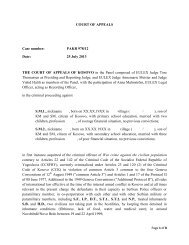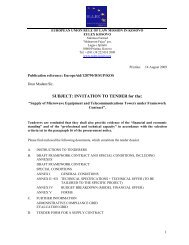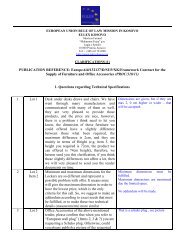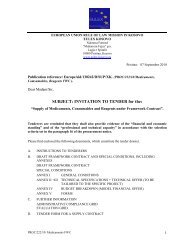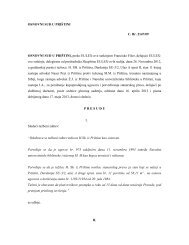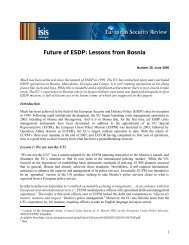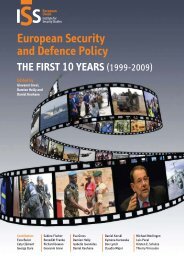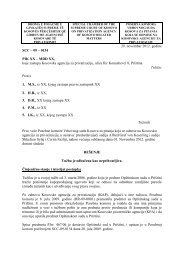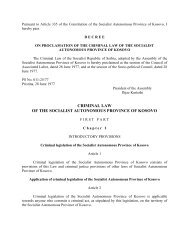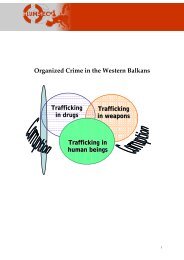DEPARTMENT OF FORENSIC MEDICINE EULEX-KOSOVO EULEX ...
DEPARTMENT OF FORENSIC MEDICINE EULEX-KOSOVO EULEX ...
DEPARTMENT OF FORENSIC MEDICINE EULEX-KOSOVO EULEX ...
You also want an ePaper? Increase the reach of your titles
YUMPU automatically turns print PDFs into web optimized ePapers that Google loves.
Contacts were made with Macedonian and Albanian authorities concerning potential graves located on their<br />
territories.<br />
SECTION 3- <strong>FORENSIC</strong> ANTHROPOLOGY RESULTS<br />
As a result of the identification work conducted at <strong>EULEX</strong>/DFM, 103 individuals were positively identified in<br />
2010, 57 of which were missing persons.<br />
Forensic Anthropological work resulted in the selection of 580 bone samples for further analysis including<br />
genetic profiling conducted by ICMP. Additionally, 231 bone samples were re-associated to other<br />
individuals.<br />
A detailed analysis and evaluation of several cases of commingled and burnt remains from several regions<br />
in Kosovo was conducted. An identical exercise was conducted with thousands of fragmented body parts<br />
from the sites exhumed in Serbia (Bajna Basta, Petrovo Selo and Batajnica). This work was conducted in<br />
conjunction with the review of over 700 files.<br />
SECTION 4- UNIDENTIFIED REMAINS<br />
4.1 INTRODUCTION<br />
The identification of the bodies and body-parts under DFM custody is of the highest priority and forms an<br />
essential component of DFM’s strategy. To this end, DFM has worked intensively in the review of every<br />
single case and has made considerable progress. Additionally, over 580 new bone samples have been sent<br />
to ICMP for DNA analysis. For the last 12 months <strong>EULEX</strong>-DFM continued to work intensively on the issue of<br />
the unidentified remains held in the morgue. The work has been labour-intensive and highly complex. The<br />
task is not finished since it requires further detailed analysis and the cooperation of Civil Society.<br />
4.2 A GUIDE TO UNDERSTANDING THE UNIDENTIFIED REMAINS AT THE DFM- Kosovo Cases<br />
There are 250 bodies.<br />
There are 101 body parts.<br />
There are 168 male bodies vs. 82 female bodies. There are 80 male body-parts vs. 21 female<br />
body-parts.<br />
All have been profiled by ICMP (all have a DNA “finger print”). However for a large number of<br />
cases, these profiles are several years old. We strongly suggest that problem cases are re-profiled<br />
using new technology and methods offered by ICMP or other labs.<br />
In 2009 and 2010, sixteen (16) samples sent in 2002 and 2003 were finally matched to blood.<br />
These cases took 7-8 years for a match to be made.<br />
For the rest of the bodies and body-parts, none of them have so far matched the blood data base,<br />
so they remain un-identified.<br />
If relatives have not given blood: their missing person could be at the DFM.<br />
We know that there are more than 250 incomplete blood samples. There are also 61 cases for<br />
which there is no blood at all.<br />
In total there are 311 cases which cannot be identified because we do not have the blood for<br />
comparison.<br />
Some of the remains buried during and after the conflict were possibly MIS-IDENTIFIED and that<br />
they may actually be missing persons, while the remains at DFM are those of persons who were<br />
never reported as missing (See Section 5: Addressing Potential Mis-identifications below).<br />
<strong>EULEX</strong>/DFM 2010 Annual Activities Report (Missing Persons Operation)<br />
6



